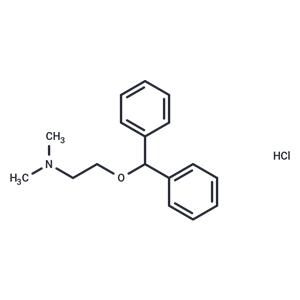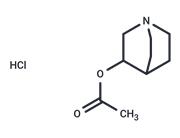| Name | Diphenhydramine hydrochloride |
| Description | Diphenhydramine hydrochloride (DPH) is a histamine H1 antagonist used as an antitussive and antiemetic. It is also used for pruritus and dermatoses, for hypersensitivity reactions, as an antiparkinson, a hypnotic, and as an ingredient in common cold preparations. |
| In vitro | Diphenhydramine blocks tetrodotoxin-sensitive (TTX-S) and tetrodotoxin-resistant (TTX-R) sodium currents with K(d) values of 48 mM and 86 mM, respectively, at a holding potential of -80 mV. Diphenhydramine shifts the conductance-voltage curve for TTX-S sodium currents in the depolarizing direction but has little effect on that for TTX-R sodium currents. Diphenhydramine causes a shift of the steady-state inactivation curve for both types of sodium currents in the hyperpolarizing direction. Diphenhydramine produces a profound use-dependent block when the cells are repeatedly stimulated with high-frequency depolarizing pulses. [1] Diphenhydramine induces apoptosis in a dose- and time-dependent manner in both CCRF-CEM and Jurkat cell lines, whereas Cimetidine fails to induce significant effects at similar concentrations. Diphenhydramine-induced apoptosis is evaluated in terms of morphology, flow cytometry, and the release of cytochrome c to the cytosol. Diphenhydramine inhibits cell proliferation without inducing apoptosis in human peripheral blood mononuclear cells. [2] Diphenhydramine (500 nM) significantly reduces the baseline firing of the periaqueductal gray neurons without a significant effect on the frequency of postsynaptic potentials. Diphenhydramine at high concentration inhibits periaqueductal gray neurons, but at low concentrations it has no effect on the baseline-firing rate and it blocks the response to neurotensin and tomedial preoptic nucleus stimulation. [3] |
| Storage | Powder: -20°C for 3 years | In solvent: -80°C for 1 year | Shipping with blue ice/Shipping at ambient temperature. |
| Solubility Information | 10% DMSO+40% PEG300+5% Tween 80+45% Saline : 2 mg/mL (6.85 mM), Sonication is recommended.
DMSO : 45 mg/mL (154.2 mM), Sonication and heating are recommended.
|
| Keywords | Inhibitor | inhibit | HistamineReceptor | Histamine Receptor | H1 receptor | Endogenous Metabolite | Diphenhydramine hydrochloride | Diphenhydramine Hydrochloride | Diphenhydramine |
| Inhibitors Related | Sucrose | Neomycin sulfate | Aceglutamide | Emtricitabine | Levulinic acid | D(+)-Raffinose pentahydrate | Sulfamethoxazole sodium | Tributyrin | Glycerol | Thymidine | Sodium 2-hydroxybutanoate | BES |
| Related Compound Libraries | Failed Clinical Trials Compound Library | Anti-Neurodegenerative Disease Compound Library | Bioactive Compound Library | Pain-Related Compound Library | Membrane Protein-targeted Compound Library | Anti-Cancer Clinical Compound Library | Drug Repurposing Compound Library | Inhibitor Library | Natural Product Library for HTS | FDA-Approved Drug Library | Bitter Compound library | Immunology/Inflammation Compound Library |

 United States
United States






